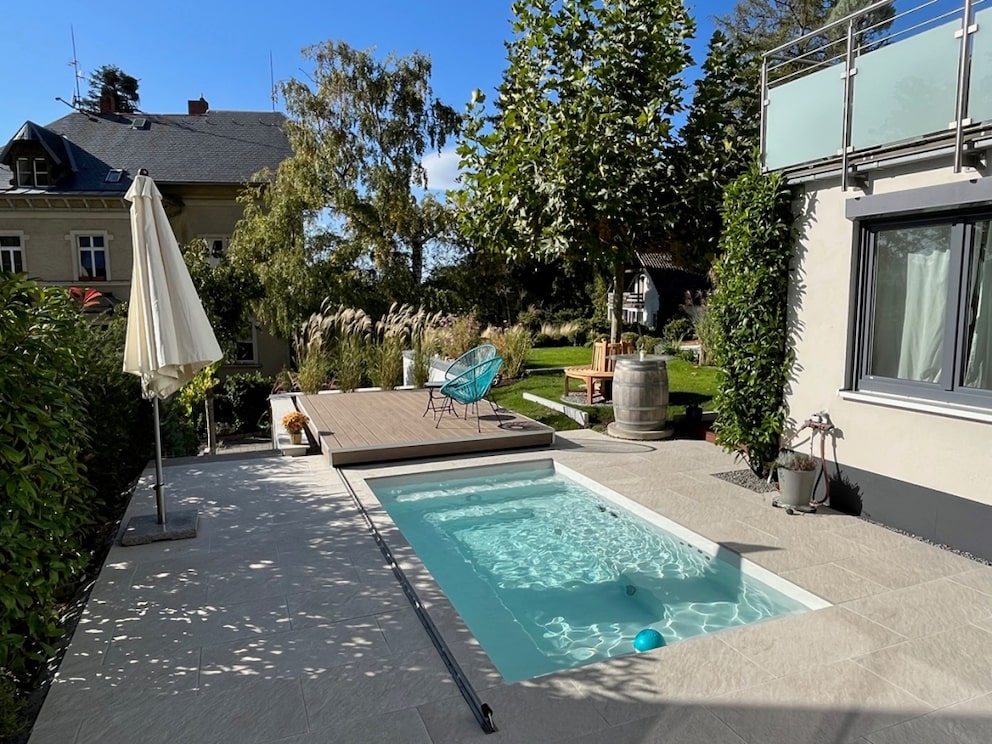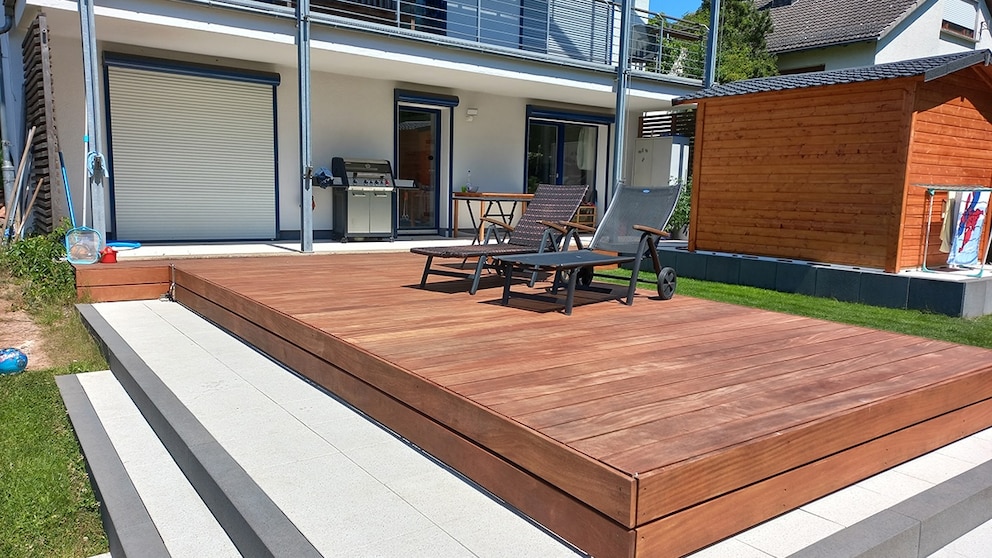March 19, 2025, 4:09 pm | Read time: 7 minutes
Mobile decking is a practical and flexible solution for outdoor areas and gardens. Here you can find out who it is suitable for and what advantages it offers.
A patio is the perfect place to enjoy the sun and relax at home. However, fixed patio designs are not always the best option. An adjustable concept can often be more versatile. myHOMEBOOK presents an overview of mobile decking.
Overview
What Is Mobile Decking?
Mobile decking is extremely flexible. It can be set up, extended, or reduced in size almost anywhere. The modules are made of wood, WPC (wood-plastic composite), or aluminum and are very easy to install thanks to practical plug-in or click systems. In most cases, no foundation is required. Some models are even height-adjustable, making it easy to level out uneven floors. Whether in the garden, on the balcony, or on the roof terrace — with a mobile deck, you can quickly and easily create a cozy oasis of well-being outdoors.
Who Is Mobile Decking Suitable for?
Mobile decking is suitable for anyone who is looking for an alternative to a classic patio — regardless of whether they own a house or apartment with a garden or roof terrace. Tiny house residents, campers, tenants with a balcony or terrace and even pool owners can also benefit from this flexible solution. In the catering industry, mobile decking offers a practical way to extend the outdoor area on a seasonal basis.
Why Can Mobile Decking Be Useful?
Mobile decking is a clever solution because it usually requires no planning permission and is tenant-friendly. The modules can be individually adapted, extended, and moved — without the need for fixed anchoring. Installation is much easier than with conventional patios, and the costs are usually lower than those of a permanently installed alternative.
It is particularly practical for rented apartments with a garden or small properties, as it protects the ground. The modules can also be partially covered and weatherproofed so that they can be used all year round.
Advantages of Mobile Decking
1. Flexibility
The advantages of mobile decking are obvious. The modules offer maximum flexibility and are ideal for anyone who cannot or does not want to build a fixed patio. They can be extended, reduced, or rearranged as required — without great effort or structural restrictions. This makes them a practical and adaptable solution for different living situations.
2. No Time-Consuming Installation and Approval
The prefabricated decking is easy to assemble as it is based on a practical plug-in or click-in principle, meaning that no foundation or other complex construction is required. Normally, the ground has to be excavated for a patio — with mobile decking, the effort is less, as there is no need for excavation, compaction, traveling, and leveling. Depending on the manufacturer and construction method, a strip foundation can still be useful.
As already mentioned, planning permission is not usually required for mobile patios as they are not permanently anchored. However, if you are unsure, it is advisable to contact the local authority for more information.
3. Mobile Decking Is Sustainable and Reusable
Many mobile decks are made of recyclable or particularly durable materials that can easily be taken with you when you move house and reassembled at another location. This not only makes them sustainable but also extremely practical for changing living situations. In a camping situation, for example, a mobile deck creates a stable and dry area for sitting, eating, and relaxing. They can be set up and dismantled in a short space of time, which can be ideal for spontaneous use.
How Do You Install Mobile Decking?
Some manufacturers offer a comprehensive package where the mobile deck is assembled upon delivery. Alternatively, you can also assemble it yourself. Depending on the model or manufacturer’s instructions, it is important to prepare the surface accordingly. In most cases, the surface should be secure and level to ensure a stable base. If necessary, you can lay a protective layer of weed fleece or rubber mats to prevent weed growth and protect the ground. A layer of gravel can also be helpful to drain away moisture, which can protect the patio and extend its lifespan.
Some models are equipped with integrated frames or adjustable feet, which can make installation much easier. These elements ensure that the decking is stable and that the load is distributed evenly. If the surface is uneven, support pads or height-adjustable elements can be used to compensate for the different heights and prevent wobbly spots.
Depending on the model, installation is carried out using a plug-in or click system, allowing individual modules to be either reduced or enlarged. With wooden decking, it is important to lay the boards with a small gap between them to ensure sufficient ventilation and prevent waterlogging. This could otherwise damage the material. Once the decking has been installed, you should finally check the stability once again to ensure that everything is standing properly and securely.
The Difference Between Pool Decks on Rails and Mobile Decking
A pool deck on rails is a type of mobile deck, as it can slide over the pool and serve both as a walkable surface and a pool cover. The difference, however, is that pool decks on rails have been specially developed for pools and can only be moved using a fixed rail system.
The installation process also differs from that of a mobile deck. While a mobile deck can often be set up independently of the ground, the rails of a pool deck are firmly anchored. A precisely aligned rail construction is therefore required, which must also be fixed to a stable foundation.
Since the rails need to be securely anchored, obtaining a building permit may be necessary, given that legal requirements vary by region. It is, therefore, important to check with the building inspectorate or the relevant local authority before starting construction.

How Do You Care for and Maintain Mobile Decking?
As with any decking, care, and maintenance are also required for mobile decking to keep it beautiful and functional. Regular and thorough cleaning is therefore important and protects against dirt and debris. Depending on the material, the decking should be cleaned with mild cleaning and care products recommended by the manufacturer. Soft brushes are ideal as they are gentle on the material. High-pressure cleaners, on the other hand, are not recommended as they can often damage the structure of the wood or slabs.
Wooden decking occasionally requires a protective treatment that penetrates deep into the wood. This protects the decking from mold or pests in the long term. Protection against UV radiation is also important, as the wood can otherwise fade or become brittle. Special UV protection sealants or wood oils can help here, preventing the wood from drying out and preserving its natural color.
If possible, store the mobile decking in a dry place during winter. However, if winter-proof storage is not possible, the deck can also be covered with a weatherproof cover.

Flexible Solutions 6 Advantages of Precast Ceiling Panels When Building a House

Irrigation 4 Methods for Collecting Rainwater in the Garden

Plants, furniture, floor care Perfectly preparing the patio for winter
How Much Does Mobile Decking Cost?
The costs vary depending on the material, size, and features. Some models are available for less than 500 euros. Other, higher-quality versions cost several thousand euros. The materials have a huge influence on the price: the higher the quality, the more expensive. It also depends on the individual features. If you want height-adjustable feet, integrated lighting, or special coatings, these can further increase the price. It is, therefore, advisable to compare several offers at the same time.

